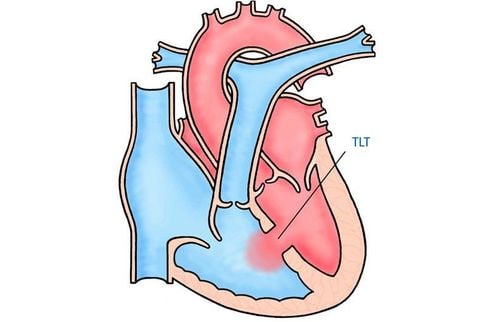This is an automatically translated article.
The article was consulted with Dr. CKII Nguyen Khanh Nam - Department of Medical Examination & Internal Medicine - Vinmec Nha Trang International General Hospital.Tongue adhesions in children is one of the lesser-known birth defects that can limit the normal movement of the tongue and speech in children.
1. What is tongue-tie?
Adhesions of the tongue are a mild birth defect that any newborn is at risk of due to a shortening of the glottis (a thin membrane of lining under the tongue) that limits normal movement of the tongue.According to statistics, about 5% of babies will have this malformation after birth and it will be detected in the first month after birth during routine health check-ups or vaccinations; or the child will be discovered later when the parents find the baby difficult to suckle, difficult to pronounce or gain weight slowly. Tongue adhesions in children can be more or less sticky.
Trắc nghiệm: các chỉ số cần chú ý về sự phát triển thể chất của trẻ
Chiều cao, cân nặng của bé ở từng giai đoạn nên là bao nhiêu là bình thường, bao nhiêu là bất thường? Cùng ThS.BS Ma Văn Thấm điểm lại xem bạn đã nắm được các chỉ số phát triển thể chất của bé chưa nhé!The following content is prepared under supervision of Thạc sĩ, Bác sĩ y khoa, Ma Văn Thấm , Nhi , Phòng khám Đa khoa Quốc tế Vinmec Dương Đông(Phú Quốc)
2. How to detect tongue-tie in children?
Sticking to the tongue is one of the reasons why babies have a lot of trouble sucking, so they will have to gain weight slowly or suckle for a long time. Depending on the degree and age of the deformity, the manifestations will be different, specifically:The tongue brake is short and restricts the movement of the tongue; The tip of the child's tongue cannot stick outside the lips; The tip of the tongue cannot touch the roof of the pharynx; When the baby cries, the tip of the tongue is heart-shaped; When the child sticks out his tongue, it has a pointed or square shape; Sticking to the tongue makes the lower front teeth tilted or open; Children who have difficulty sucking and pronouncing are also more difficult.

3. Classification of tongue adhesion in children
To be able to classify the degree of tongue adhesion in children, it is necessary to be based on the length of the tongue brake measured from the place of attachment on the floor of the mouth to the position of attachment to the tongue, there are the following levels:Level 1: Child mildly stuck to the tongue brake from 12-16 mm; Level 2: Children with an average of 8-11 mm stuck to the tongue; Grade 3: The child has severe adhesions of the tongue from 3-7 mm; Grade 4: The child has a complete adhesion of the tongue brake less than 3 mm.
4. When can a child with a tongue tie be cut?
As soon as it is discovered that a child has a tongue tie, parents should take the child to a specialist hospital to be examined and accurately assessed the degree of tongue adhesion to see if it needs to be cut or not.Normally, the indication for cutting the tongue brake will depend on the degree of adhesion more or less and the degree of influence on the pronunciation and breastfeeding process of the child. In case the child has a lot of tongue adhesions and affects suckling, it will be indicated to cut it soon, when the adhesions on the tongue cause an effect on pronunciation, it is necessary to be evaluated by a specialist in odonto-stomatology. Preoperative assessment to rule out other cases of speech difficulties in children.
In addition, the technique of cutting the tongue brake depends on the age of the child, when the child is under 3 months old, it is necessary to keep the baby's head tight, you can only apply or inject anesthetic to the child and then use an electric knife to cut. tongue brake, this technique can help the baby to suckle again immediately after cutting. However, for older children, it is possible to cut the lingual fascia under anesthesia or anaesthesia and then use a scalpel or cauterization machine to cut the lingual fascia and then suture, a few weeks after the wound heals.

5. Caring for children after surgery with tongue-tie
After performing surgery to cut tongue adhesions in children, right at the cutting site will often appear white marks, however, parents should not be too worried because this phenomenon will disappear after a few weeks. In addition to following the doctor's instructions, it is necessary to monitor and care for the child carefully, do not let the child bite or suck on hard objects to avoid bleeding, do not let the child touch the cut site to avoid infection.In addition, every day it is necessary to clean the child's mouth after eating and exercise the tongue, give the child plenty of water to help clean the mouth.
Parents can take their children to Vinmec International General Hospital to be examined and diagnosed when they see that the child has signs of adhesions on the tongue.
As a key area of Vinmec Health system, Pediatrics Department always brings satisfaction to customers and is highly appreciated by industry experts with:
Gathering a team of top doctors and nurses in Pediatrics : consists of leading experts with high professional qualifications (professors, associate professors, doctorates, masters), experienced, worked at major hospitals such as Bach Mai, 108.. Doctors All doctors are well-trained, professional, conscientious, knowledgeable about young psychology. In addition to domestic pediatric specialists, the Department of Pediatrics also has the participation of foreign experts (Japan, Singapore, Australia, USA) who are always pioneers in applying the latest and most effective treatment regimens. . Comprehensive services: In the field of Pediatrics, Vinmec provides a series of continuous medical examination and treatment services from Newborn to Pediatric and Vaccine,... according to international standards to help parents take care of their baby's health from birth to childhood. from birth to adulthood Specialized techniques: Vinmec has successfully deployed many specialized techniques to make the treatment of difficult diseases in Pediatrics more effective: neurosurgery - skull surgery, stem cell transplantation. blood in cancer treatment. Professional care: In addition to understanding children's psychology, Vinmec also pays special attention to the children's play space, helping them to have fun and get used to the hospital's environment, cooperate in treatment, improve the efficiency of medical treatment.
Please dial HOTLINE for more information or register for an appointment HERE. Download MyVinmec app to make appointments faster and to manage your bookings easily.














